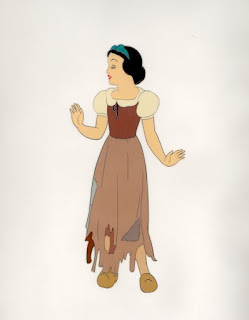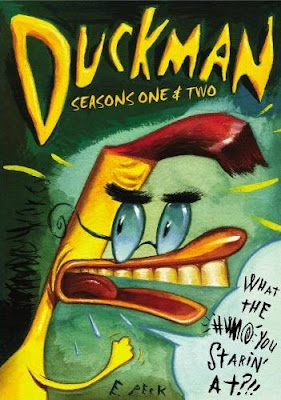I've followed computer-generated animation from the early experiments, through Tron (1982) to Toy Story. I also love the more ambitious recent animated TV like Invader Zim and Samurai Jack. Of course, Japanese anime providea high alternate benchmark to Pixar's productions, with visually beautiful and more complex, adult stories.
The ultimate memento from any animation is the original artwork, painted onto clear plastic cels - the actual item that was photographed as part of the finished film. These often look like the Roger Rabbit cel above, as they were usually laid over painted backgrounds, or over live-action in the case of Roger.
When we were in Los Angeles earlier in the year, we visited the Van Eaton Gallery, situated North of the Hollywood Hills in the Sherman Oaks neighbourhood. This fantastic double-fronted store displays and sells hundreds of animation cels and drawings.
It's like a museum of animation history, with examples of American and English animation as far back as the silents - they recently had some of the drawings used in Winsor Mackay's Gertie the Dinosaur (1911), like the one above.
Nowadays, painted colour cels are no longer used in animation, due to the crossover to computers. The pictures above are examples of what you can collect from modern productions. The first is a pencil drawing from The Batman series. It's the only hand-crafted art that's needed. The drawing is scanned in and the rest of the animation process (inking, inbetweening, colouring) is done in the computer. The Simpsons is now done this way, having swapped from cel animation after Season Thirteen. The second Batman item is therefore a painted cel recreated as if it was made using the old method, but this item wasn't actually photographed for the TV show. It's purely made for the collectors' market, looking more desirable than the line drawing.
I was mainly interested in the older, original cels and there's a very wide choice. Cult animators like Richard Williams (The Thief and the Cobbler, Who Framed Roger Rabbit?) and Ralph Bakshi (Fritz the Cat) were well-represented, and we were surprised to see reasonably-priced cels from the animated Lord of the Rings movie (1978), like the above shot of Frodo. There were also more unusual items - from the animated sections of live-action films like Tron (which used just as much cel animation as early computer animation), Xanadu and even Mr DNA from Jurassic Park.
There were colourful, large-format, Don Bluth cels from the Space Ace and Dragon's Lair arcade games (which I heard may still be resurrected on Blu-Ray). They also had cels from his many feature films, like An American Tail.
The gallery's priciest items are naturally Disney films, all the way back to the first animated feature film, Snow White and the Seven Dwarfs (1937). I was surprised that anything was still available from the old classics. Less expensive, but still pricey, are the current hit series like The Simpsons. But there were also many bargains on offer too - like original 1970's Godzilla cels for $35 each.
If you're ever in Los Angeles you'll need a car to get to the store in Sherman Oaks, but they'll also ship items everywhere via their website.







































